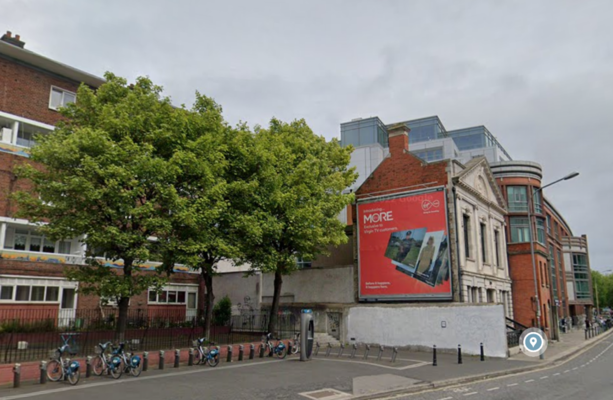PLANNING PERMISSION FOR a new digital billboard on Dublin’s Kevin Street Lower next to council flats that were dubbed by architects as “poor quality architecture” has been refused.
The application was made by JCDecaux, with a the conservation method statement compiled by Anello Architects on behalf of the advertising company.
A similar digital display is located nearby on the corner of Wexford Street.
Sinn Féin Senator Lynn Boylan submitted a planning observation defending the Bishop Street flats, first built in the 1960s, that are located beside the proposed billboard site.
A Dublin Inquirer article on the design states that heritage office at Dublin City Council don’t have information on who actually created the mosaics.
No regular replacement of posters would eliminate the “stress” caused by the process of changing and glueing the displays, the report cited.
‘Urban presence’
In her submission, Boylan said Anello Architects argues that the replacement of the current billboard with a digital one will have a positive impact on the “urban presence” [of the protected structure at number 40 Kevin St] because it “will further distance it from the adjacent gable rhythm of the poor quality architecture of the council flats dating back to the last century”.
In her observation, which is also supported by Sinn Féin’s Eoin Ó Broin and Chris Andrews, she argued “the flats are wonderful architecture that are well situated and comprehensively designed in relation to the protected structure. They do not need to be “distanced from” the protected structure.
“As the Development Plan notes, ‘high-quality architecture of all periods combines with a strongly defined urban form of streets, squares and spaces to create a dynamic metropolis with a very special sense of place.’ That is especially true of Kevin St. The replacement of the billboard with a digital panel would have a negative consequence on the urban presence.
“It is regrettable that the gable of the protected structure is covered by the advertising panel. The advertising panel should be ‘distanced’ from the protected structure and not replaced with a digital one, and certainly not distanced from the council flats,” said the senator in her submission.
No news is bad news
Support The Journal
Your contributions will help us continue
to deliver the stories that are important to you
‘Adverse impact’
Dublin City Council rejected the application, stating that the proposal illuminated digital display “would have a significant adverse impact on adjoining residential amenity, would result in visual clutter and have a negative visual impact on the character of the street”.
In its decision, the council considered that the increased luminosity of the signage, frequency of advertisement change represents an intensification of use on the site, and would have a significant adverse impact on adjoining residential amenity.
It added that the proposed LED advertisement structure, by reason of its excessive scale and proportions, appearance and location on the façade of this protected structure, would have an adverse visual impact on and would seriously detract from and injure the special architectural character and legibility of both the protected structure it would be mounted to.

